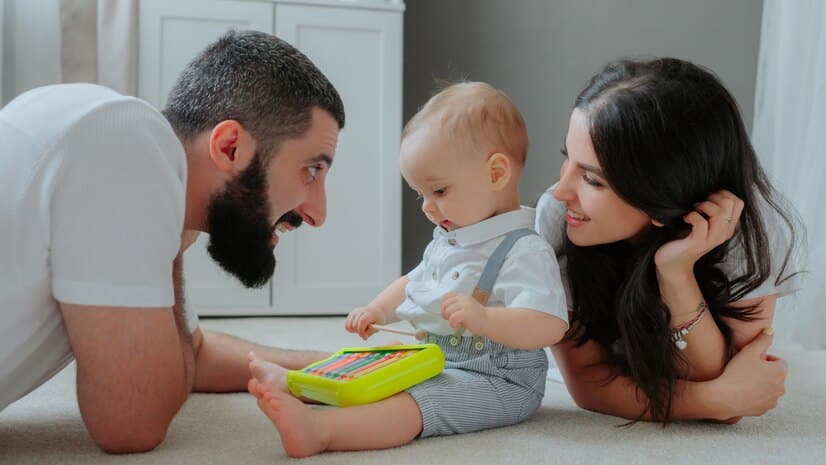Are you a parent-to-be, or perhaps you already have your baby? If so, this article is for you! Reflexes Babies are born with excellent reflexes that can be fascinating and helpful for parents to understand. Learn about them in this guide and how they can help your little one grow and develop!
Introduction
As soon as babies are born, they start to develop their reflexes. Some of these fantastic reflexes include the rooting reflex, which helps them to breastfeed; the sucking reflex, which helps them to suck on a pacifier or bottle; and the Moro reflex, which helps them to startle and cry when they feel scared or threatened.
These reflexes are essential for survival, but they can also be a source of frustration for parents trying to get their baby to sleep through the night! Here is a guide to help you understand your baby’s incredible reflexes and how you can help your little one learn to control them.
Moro Reflex
The Moro reflex is one of the most amazing reflexes that babies are born with. This reflex, also known as the startle reflex, is elicited when a baby feels sudden movement or loud noise. The reflex leads to the baby throwing their arms out to the side and arching their back. This reflex usually lasts for a few seconds, and then the baby will return to their normal position.
The Moro reflex is a safety mechanism that helps protect babies from falling or being hurt. It is also thought to play a role in the bonding between mother and child.
When a mother picks up her baby, the sudden movement can trigger the Moro reflex, which leads to the baby reaching out and grabbing onto the mother. This can help promote bonding and attachment between mother and child.
Rooting Reflex
The rooting reflex is a fantastic reflex that babies are born with. This reflex helps them to latch onto their mother’s breast and start breastfeeding. The rooting reflex is also helpful when a baby is falling asleep.
When the baby’s head falls forward, the baby will automatically turn their head to the side and start rooting. This helps the baby to get their mouth in the correct position to latch on to the nipple.
The rooting reflex usually disappears around 4-6 months old, but some babies may have it until they are 12 months old.
Palmar Reflex
When you touch your baby’s palm, its fingers will quickly close around your finger in what is known as the palmar reflex. This reflex is sometimes called the grasp reflex because of how tightly babies can hold on. The palmar reflex is among the many excellent reflexes babies are born with.
The palmar reflex is a primitive reflex, meaning it is an involuntary response not controlled by the baby’s conscious brain. Primitive reflexes are essential for survival because they help babies protect themselves and find food.
The palmar reflex helps babies hold onto their mother’s hair or fur when being carried, preventing them from falling. It also helps them grip anything they put into their mouth, which aids in exploration and eating.
The palmar reflex usually disappears by 4-6 months old as the baby’s brain develops more voluntary control over its muscles.
However, some children may retain this reflex longer, which can cause problems with writing and using utensils correctly. Talk to your doctor or pediatrician if you are concerned about your child’s development.
Babinski Reflex
The Babinski reflex is one of the fantastic reflexes babies are born with. This reflex is when the big toe moves up, and the other toes fan out when the bottom of the foot is stroked. This reflex disappears by 4 to 6 months old.
Tonic Neck Reflex
One of the first excellent reflexes that babies are born with is the tonic neck reflex. This reflex is also called the fencing reflex or the Moro reflex.
When a baby’s head is turned to one side, the arm and leg on that side of the body straighten out, while the arm and leg on the other side bend at the elbow and knee. This reflex helps babies develop their neck muscles and learn to control their head movements.
The tonic neck reflex usually disappears by 4-6 months of age but may reappear when a baby is startled or upset. If your baby startles easily or seems unhappy when you move them, it may be due to this reflex. You can help your baby through this phase by holding them close and providing reassurance.
Plantar Reflex
When babies are born, they are equipped with a number of reflexes that help them survive and adapt to their new environment. One of these reflexes is the plantar reflex, which is also sometimes referred to as the Babinski reflex. This reflex is elicited when the sole is stimulated, causing the big toe to extend and the other toes to fan out.
The plantar reflex is present at birth and usually disappears when a child reaches 12 months old. It is thought to be an essential primitive reflex that helps babies to protect their feet from injury. When stimuli are applied to the bottom of the foot, it triggers a response in the central nervous system, which causes the muscles in the foot to contract and helps the baby to avoid injury.
While this reflex is considered normal, it can sometimes indicate neurological problems. If your child has persistent plantar reflexes beyond infancy, it may be worth discussing with your doctor or pediatrician.
Step Reflex
The first reflex that babies are born with is the stepping reflex. This reflex allows them to take their first steps when they’re ready. Parents need to know about this reflex to be prepared to help their children when the time comes.
The step reflex is a natural response that helps babies learn to walk. When a baby feels pressure on their feet, they will automatically start to move their legs in a walking motion. This reflex usually appears around six months of age, but some babies may start sooner.
As your baby shows signs of the stepping reflex, you can encourage them by holding their hands and helping them balance. You can also put toys or objects just out of reach, so they must take a few steps to get them. Just make sure you support your baby in case they fall.
With time and practice, your baby will eventually gain the coordination and strength necessary to take independent steps. Until then, enjoy their cute wobbly steps as they learn this new skill!
Galant Reflex
If you’ve ever seen a newborn baby startle at a loud noise or quickly turn their head to follow a moving object, you’ve witnessed one of the many excellent reflexes they are born with.
Newborns come equipped with several inborn reflexes and automatic responses to various stimuli. While some reflexes disappear as the baby grows and develops other voluntary motor skills, others persist into childhood and beyond.
For example, the Moro reflex is often called the startle reflex. If an infant is suddenly startled by a loud noise or feels like they are falling, they will often throw their arms out to the side and cry out. This reflex helps them protect themselves and can be pretty alarming for parents who aren’t expecting it!
Another common reflex is the sucking reflex, which helps newborns feed. When something touches an infant’s lips or tongue, they instinctively suck on it. This reflex is strong enough that even if newborns aren’t hungry, they may start sucking on their fists or a blanket.
Other common newborn reflexes include:
* The rooting reflex – when something strokes an infant’s cheek, they will turn their head toward it and open their mouth, preparing to feed
* The grasp reflex – when an object touches an infant’s palm, they will close their fingers around it
* The stepping reflex – when an infant’s feet touch a solid surface, they will lift their legs
Read more about Baby Brain Waves…
Conclusion
Babies are born with many reflexes that help them survive and develop. As a parent, it is essential to understand these reflexes to recognize if your baby has any problems or delays in development.
Knowing how to respond appropriately when your infant displays certain reflexes can also help create a strong bond between you and your child.
We hope this guide has been informative and will give you the confidence to provide for your little one during their early developmental years!




